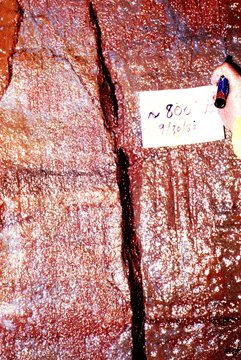
Water Also Runs Downhill
At the WIPP site, above the salt beds that hold the repository, water flows through a fractured and porous aquifer in the Rustler Formation. The fractures developed when salt was dissolved from beneath the Rustler, causing the aquifer to collapse. The collapsed occurred along a narrow band that extends in a north-south direction across the center of the site. Water in the aquifer also flows from north to south and follows the narrow band of fractures across the center of the site. So far, this is straightforward geology. But at this point the story becomes complicated because DOE geologists claim that salt has not been dissolved from within and beneath the Rustler Formation at the WIPP site and that the fractures are geologically old (see Mendaceous Science, Example 1). Flow of water along a narrow band at the site, however, means that dissolution in the fractures is active and the flow is changing over time.
Here is a simple geologic observation that makes perfect sense. Water is a solvent and when water passes through a geologic formation it dissolves part of the rock and the dissolved chemical substances become concentrated in the water. The concentration normally increases as the water moves through a permeable geologic formation. Except, not at WIPP, where the concentration decreases as the water moves southward in the narrow band across the site. At first, DOE geologists explained the lower concentration by claiming that it was old fresh water left over from the Ice Age. When this explanation made no sense they abandoned the question and have no further answer to the riddle. The answer, however, is obvious. Water at a low concentration is somewhere and somehow being added to the flow as it moves across the site. Without knowing the somewhere and the somehow it is not possible to claim that dissolution has stopped because when water has a low concentration of ions it can dissolve more rock. The fractures in the aquifer are probably still enlarging and this means that their hydrologic model won't work over the next 10,000 years.
A huge boring machine drilled out the main shaft at the center of WIPP and the freshly cut walls were exposed for inspection and photography. Several photos taken before the shaft was sealed reveal dissolution. In one photo of soluble rock in the Rustler Formation the walls of a hairline fracture have been dissolved away, leaving a gaping crack large enough to insert one's fingers.

A fracture this large must have carried a lot of water, and from its fresh appearance and lack of cement and fracture filling, not too long ago. The photo, taken by a geologist working for the New Mexico EEG http://www.rt66.com/~eeg/home.htm, belies the claim that dissolution at the WIPP site never happened and if it did it is geologically old and now dead.
Having an aquifer with slow moving water was one of the very first criteria in the arsenal of rules for nuclear waste disposal. The members of the committee that made the rules reasoned that the most likely means for spreading contamination was moving water. By giving us an incorrect history of dissolution and by failing to solve the mystery of decreasing concentration in the aquifer we have another example of DOE and EPA opting for the "best case."
PREVIOUS PAGE............NEXT PAGE